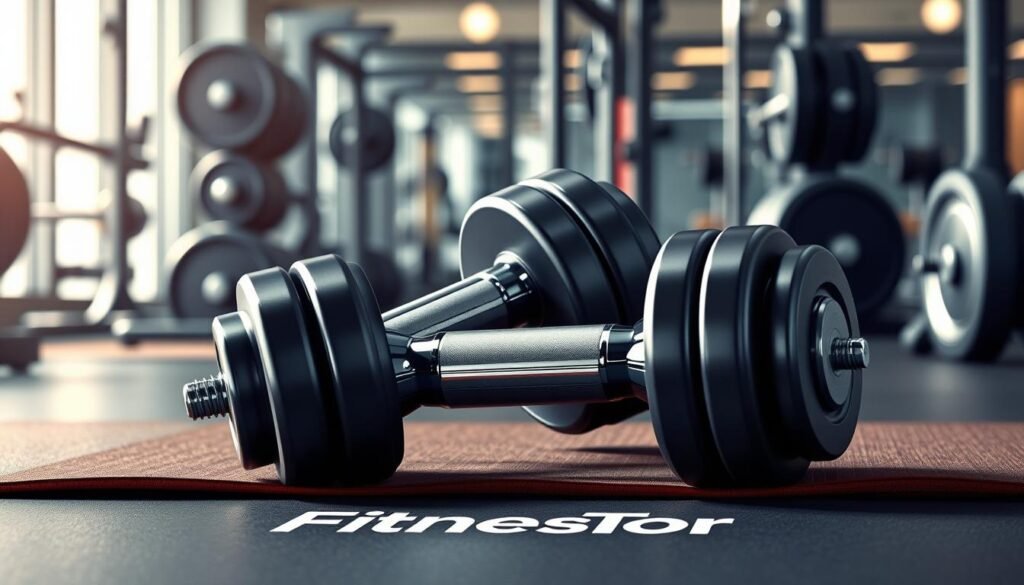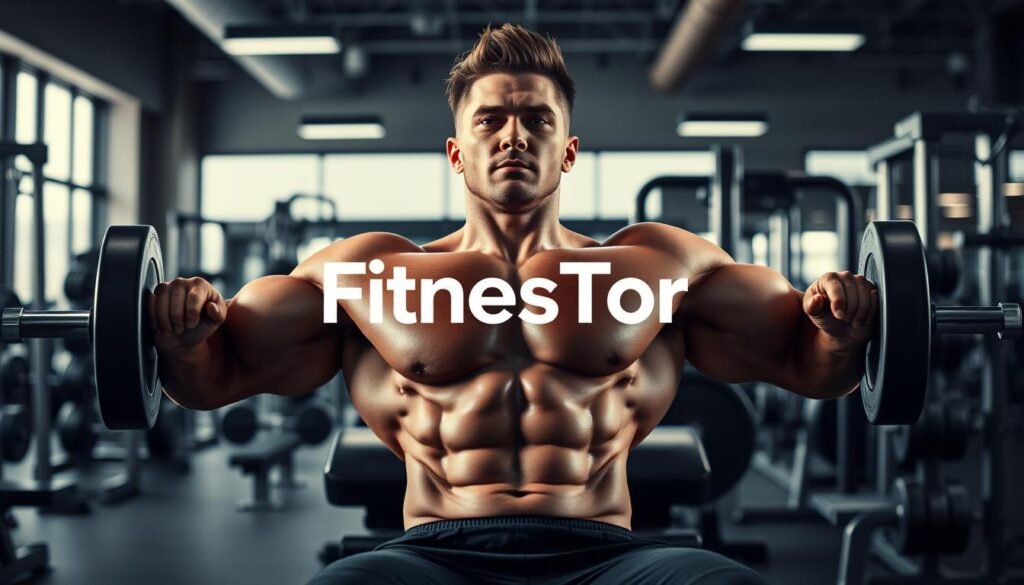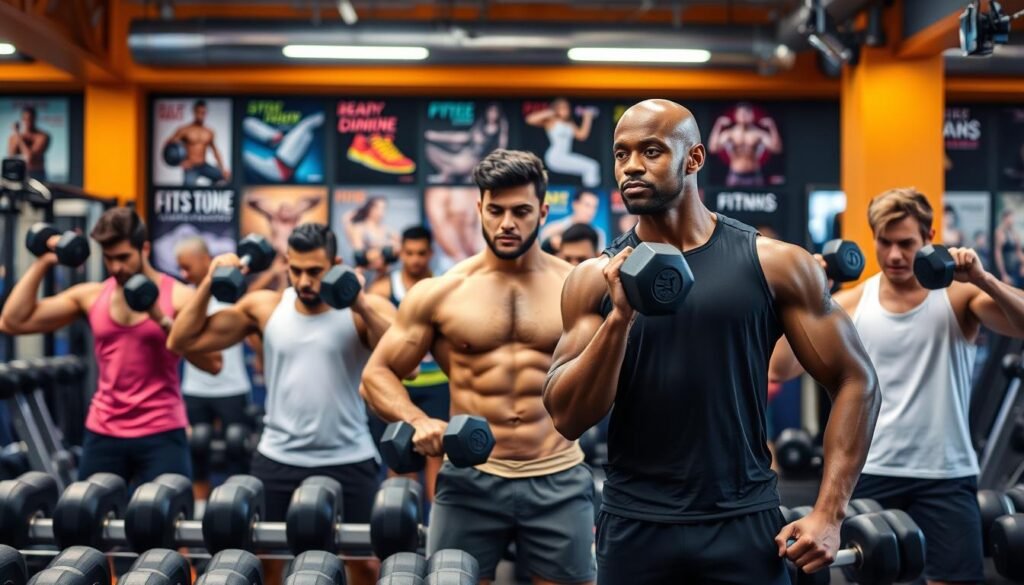We’re excited to share our guide on building a big and defined chest. We’ll focus on the best chest exercises and workout routines. Plus, we’ll give you tips for a bigger chest1. A good chest workout is key for a strong and defined chest. We’ll cover the different chest muscles and exercises to help you reach your goal.
Building a big chest requires proper nutrition, a consistent workout, and patience. Jeff at Athlean X stresses the importance of nutrition and exercise for losing fat and building muscle1. We’ll talk about the importance of chest exercises like the bench press. And we’ll give you a detailed guide to a big and defined chest through a structured workout.
Key Takeaways
- We will explore the best chest exercises and chest workout routines for building a big and defined chest.
- A well-structured chest workout is essential for achieving a strong and defined chest.
- Proper nutrition and consistent workout routine are key for building a big chest.
- Patience and dedication are necessary for significant chest development results.
- We will provide tips and guidelines for creating an effective chest workout plan.
- Our guide will cover the different types of chest muscles and exercises to help you achieve your goal.
By following our guide and adding the best chest exercises and workout routines to your routine, you can get a big and defined chest. This will improve your overall physique1. We’ll give you the tools and knowledge to reach your fitness goals and build a strong, confident chest.
Understanding Chest Anatomy and Muscle Function
To build a strong chest, knowing the chest muscles is key. The chest muscles, or pectoral muscles, have two main parts: the upper and lower chest2. The upper chest helps with shoulder movements like flexion and adduction. The lower chest aids in shoulder extension and adduction.
The pectoral muscles are vital for chest growth. They work together to help us push, pull, and lift. A strong chest boosts athletic performance and looks great too.
Here are some important facts about chest anatomy and muscle function:
- The upper chest muscle group is responsible for movements such as shoulder flexion and adduction2.
- The lower chest region is responsible for movements such as shoulder extension and adduction2.
- The pectoral muscles work together to enable movements such as pushing, pulling, and lifting2.
Knowing how the chest muscles work helps in creating better workout plans2. This knowledge is essential for reaching fitness goals and getting a strong, defined chest.
Essential Equipment for Chest Development
Building a big and defined chest needs the right tools. We suggest getting a good set of dumbbells, like the BowFlex SelectTech 552 Adjustable Dumbbells. They are versatile and save space3. These dumbbells are great for chest presses and flys, hitting the chest from different sides.
Barbell exercises are also key for a strong chest. The bench press is a classic that targets the chest. You’ll need a quality barbell and bench for it2. Always focus on proper form and technique to avoid injury and get the most out of your workout.
Here are some benefits of using adjustable dumbbells and barbells for chest development:
- Increased versatility in your workout routine
- Space-saving design for home gyms
- Improved safety and effectiveness in your workouts

By adding dumbbell exercises, barbell exercises, and the bench press to your routine, you can build a strong and defined chest4. Always remember to focus on proper form and technique. Also, invest in good quality equipment for your safety and effectiveness in workouts.
| Equipment | Benefits |
|---|---|
| Dumbbells | Increased versatility, space-saving design |
| Barbells | Improved safety and effectiveness, classic exercises like bench press |
Best Exercises to Build a Big and Defined Chest: The Fundamentals
Building a big and defined chest requires proper form and technique. A good chest workout should include exercises for both the upper and lower chest. Athlean X says that proper form is key for a strong and defined chest5.
Start your chest workout with the basics: bench press, dumbbell press, and incline press. These exercises target the chest from different angles. It’s important to focus on proper form, breathing, and range of motion.
Proper Form Techniques
Proper form is essential for a big and defined chest. Squeeze your chest muscles at the top of the movement and keep your back straight. Use a weight that lets you maintain proper form to avoid injury5.
Range of Motion Guidelines
Following range of motion guidelines is also key. Use a full range of motion to target the chest from all angles. Avoid locking out your joints to prevent injury and ineffective workouts.
By following these guidelines and using the right exercises, you can build a big and defined chest. Always focus on proper form and use a weight that allows for it. With consistent practice and dedication, you can reach your chest workout goals5.
Mastering the Bench Press
To build a big and defined chest, mastering the bench press is key. The bench press works the chest, shoulders, and triceps5. We’ll cover the flat bench press and its variations, like the incline and decline presses.
The flat bench press is the most common type. It’s done on a flat bench5. Lie on the bench, grip the bar wider than your shoulders, and lower it to your chest. Then, press it back up.
Proper Technique for Incline and Decline Press
There are also incline and decline presses. The incline targets the upper chest, while the decline works the lower chest5. For the incline, adjust the bench and press as you would flat. For the decline, adjust the bench and press.

Remember, proper form is vital for all bench press variations5. Squeeze your chest at the top and avoid arching your back or using momentum.
Tips for Mastering the Bench Press
To master the bench press, start with a weight that lets you keep proper form5. As you get stronger, increase the weight. Focus on squeezing your chest and avoid using momentum.
Dumbbell Exercises for Chest Definition
Dumbbell exercises are a fantastic way to mix up your chest workout. They help target the pectoral muscles from various angles6. Exercises like the dumbbell press and dumbbell fly are great for getting a defined chest. Adding these to your routine can boost your chest muscle development.
Using dumbbells for chest workouts has many benefits. They offer a wider range of motion and can focus on specific chest areas. Dumbbell exercises also enhance chest definition by introducing more movement and angles. For instance, the dumbbell press can be done with an incline or decline to work the upper and lower chest.
Here are some essential dumbbell exercises for your chest workout:
- Dumbbell press: targets the chest muscles from different angles
- Dumbbell fly: enhances chest definition by focusing on the pectoral muscles
- Dumbbell pullover: targets the upper chest muscles and boosts overall chest development

Adding these dumbbell exercises to your routine can enhance your chest muscle development and definition6. Always focus on proper form and technique to get the most out of these exercises safely and effectively.
| Exercise | Target Muscle | Benefits |
|---|---|---|
| Dumbbell press | Chest muscles | Improves chest definition and overall development |
| Dumbbell fly | Pectoral muscles | Helps to improve chest definition and target specific areas of the chest |
| Dumbbell pullover | Upper chest muscles | Targets the upper chest muscles and helps to improve overall chest development |
Advanced Training Methods for Chest Development
We think advanced training methods can boost your chest workout. Athlean X says using drop sets and super sets can grow muscles and increase strength. These methods make workouts more intense and varied, perfect for the chest.
Some top advanced training methods for the chest are:
- Drop sets: do a set until you can’t do more, then lower the weight and keep going.
- Super sets: do two or more exercises one after another without a break.
- Progressive overload techniques: slowly increase the weight or resistance in your workouts.
Adding these methods to your routine challenges your muscles in new ways. It’s key to focus on proper form and technique to avoid injuries and maximize your workout.
Drop sets, super sets, and progressive overload can elevate your chest workout. By using these methods and focusing on form, you can build a stronger, more defined chest. This will also enhance your overall fitness and health.
Common Mistakes in Chest Training
Building a big and defined chest requires avoiding common mistakes. Athlean X warns that poor form and not enough recovery can slow muscle growth and strength7. It’s key to hit the chest from different angles and with various resistances for balanced growth7.
Common errors include form errors like bad posture, not using full motion, and neglecting core muscles. Also, programming mistakes like not changing exercises, not increasing weight, and not resting enough can slow progress. A good chest training program should mix exercises like bench press, dumbbell press, and incline press, and include enough rest8.
Here are some tips to avoid common mistakes in chest training:
- Use proper form and technique when performing exercises
- Vary your exercises to target different muscle groups
- Increase the weight or resistance as you get stronger
- Allow for adequate recovery time between workouts
To achieve your chest goals, avoid mistakes and stick to a structured program. Always focus on proper form, mix up your exercises, and rest enough7.
| Exercise | Sets | Reps |
|---|---|---|
| Bench Press | 3-5 | 8-12 |
| Dumbbell Press | 3-4 | 10-15 |
| Incline Press | 3-5 | 8-12 |
Bodyweight Chest Exercises for Home Training
We think bodyweight exercises are perfect for working out your chest at home. They’re effective for building strength and muscle without any equipment9. You can do push-ups, dips, and chest presses at home to target your chest muscles.
Bodyweight exercises for the chest have many benefits. They increase strength and muscle, improve fitness, and boost bone density5. Plus, you can adjust them to fit your fitness level. For example, try push-ups on knees for an easier version or diamond push-ups for a harder one.
Here are some tips for getting the most out of bodyweight chest exercises at home:
- Start with lower numbers of reps and sets and gradually increase as you build strength and endurance
- Focus on proper form and technique to avoid injury and get the most out of each exercise
- Incorporate variety into your workout routine to keep things interesting and prevent plateaus
By adding bodyweight chest exercises to your home workout, you can get a stronger, more defined chest without any equipment10. Always listen to your body and only do what feels right. Also, talk to a healthcare professional before starting any new exercise program.
Nutrition Strategies for Chest Growth
Proper nutrition is key for a big and defined chest, as Athlean X11 points out. To grow your chest, focus on the right nutrition. This includes protein, meal timing, and supplements. A good nutrition plan supports muscle growth, leading to a more defined chest.
Protein is essential for muscle growth and repair, research shows11. Eat a balanced diet with lean meats, fish, and eggs. Meal timing is also important for chest growth. It helps regulate hormones and gives you energy for workouts11.
Here are some tips for a nutrition plan that supports chest growth:
- Eat 1.2-1.6 grams of protein per kilogram of body weight daily
- Eat frequent, balanced meals to regulate hormones and provide energy
- Add healthy fats and complex carbohydrates to your diet
Follow these nutrition strategies and stay consistent with workouts for significant chest growth11. Always prioritize proper nutrition and listen to your body for the best results.
Recovery and Injury Prevention
Building a big and defined chest needs proper recovery and injury prevention. Athlean X says these are key for muscle and strength growth12. We must focus on recovery and injury prevention to avoid injuries and make sure we’re getting better between workouts. This means giving our muscles time to heal and doing exercises that strengthen the muscles around our chest and improve joint stability.
Here are some important strategies for recovery and injury prevention in chest training:
- Make sure to rest and recover enough between workouts.
- Do exercises that strengthen muscles like the shoulders and back.
- Improve joint stability and mobility with exercises like shoulder rotations and chest stretches.
- Use the right form and technique in chest exercises to lower injury risk.
By focusing on recovery and injury prevention, we can avoid injuries and keep making progress in our chest training. Research shows that working out big muscle groups like the chest burns more energy and boosts metabolism13. This shows how important it is to include chest exercises in our routine, while also taking care of recovery and injury prevention.
By using these strategies and making recovery and injury prevention a priority, we can build a strong and defined chest. We also reduce injury risk and keep making progress in our workouts. As recovery and injury prevention are vital for any good chest training program, we must focus on these to reach our goals and stay healthy and strong.
| Strategy | Benefits |
|---|---|
| Adequate rest and recovery time | Reduces risk of injury, improves muscle growth and repair |
| Exercises that strengthen surrounding muscles | Improves joint stability, reduces risk of injury |
| Proper form and technique | Reduces risk of injury, improves effectiveness of workout |
Conclusion: Building Your Ultimate Chest Training Program
Building a big, defined chest needs a good training plan, regular effort, and patience7. It’s important to choose exercises that work on different chest muscles. Make sure to use the right form, breathing, and movement to get the most out of your workout8.
To make your chest training program the best, mix up your exercises. Use the bench press, dumbbell flyes, and bodyweight exercises like push-ups and chest dips8. Always try to lift more weight, do more reps, or add more sets to keep pushing your muscles7.
Don’t forget about your diet and rest. Eat enough protein to help your muscles grow, plan your meals well, and use supplements if needed8. Also, rest well between workouts to avoid injuries and get the best results.
By sticking to the advice in this article and making a balanced chest training plan, you’ll be on your way to a bigger, more defined chest. Stay committed, be patient, and enjoy the process8.
FAQ
What are the key exercises for building a big and defined chest?
How important is proper form and technique for chest exercises?
What are the benefits of using dumbbells for chest development?
How can advanced training methods like drop sets and super sets benefit chest development?
What are some common mistakes to avoid in chest training?
How important is nutrition for chest growth?
What are some effective bodyweight exercises for chest development?
How can recovery and injury prevention impact chest training?
FitnesTor is a cutting-edge fitness company dedicated to helping individuals achieve their weight loss and fitness goals in the most effective and sustainable way. At FitnesTor, we believe that losing weight isn’t just about shedding pounds—it’s about building healthier habits, gaining confidence, and transforming your life from the inside out.


